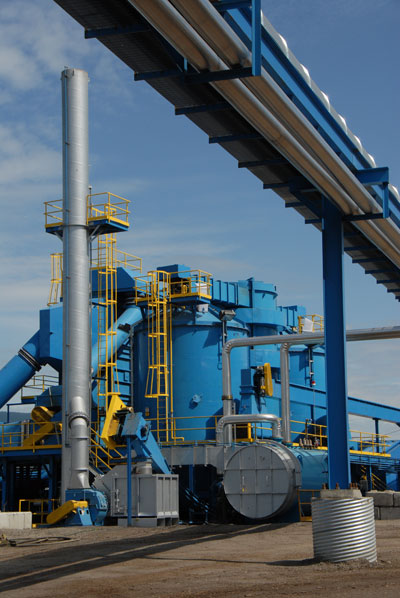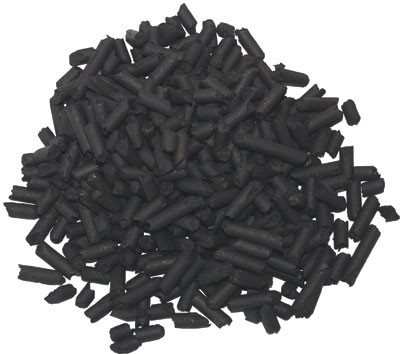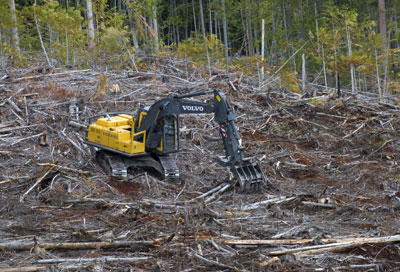
State of the Industry
February 10, 2011
By
Heather Hager
Biomass has boomed over the past few years. While helping to support a limping forest industry, it has developed into an industry in its own right.
Biomass has boomed over the past few years. While helping to support a limping forest industry, it has developed into an industry in its own right. This fledgling field continues to see new challenges, however, such as a steady decrease in the capital costs of solar- and wind-based renewable energy and continued low prices for natural gas. As the Canadian forestry industry restructures and begins to pick up again, biomass must find and settle into its own niche. Optimism is high, with some newer technologies moving towards commercial production and hopes for biomass-related policy improvements.

|
|
Economical biomass
Lumber and pulp and paper producers have long used biomass to provide heat and power for the manufacturing processes. In fact, about 60% of power used in the forest industry is currently provided by biomass, says Avrim Lazar, president and CEO of the Forest Products Association of Canada (FPAC), and recent additions and upgrades have been made with funding support from the federal Pulp and Paper Green Transformation Program. Biomass improves the economy of these operations because the fuel is on site and essentially free.
For other potential biomass users, however, the low price of natural gas and its increasingly touted reputation as the “cleaner” fossil fuel continues to be an obstacle. “The single biggest economic barrier—not just unique to forest biomass, but applicable to all renewable energy—is the low price of natural gas,” says Don Roberts, vice chairman and managing director, renewable energy and clean technology, for CIBC World Markets. Large energy consumers, such as greenhouses, that once switched to biomass to save money are switching to natural gas because of the cost and convenience. Even Ontario Power Generation, which must cease coal-fired power generation by 2014, has indicated that it’s now pursuing a conversion to natural gas, rather than biomass, at its coal-fired Thunder Bay generating station. Until fossil fuel costs increase or a fossil tax levels the playing field, focusing biomass energy efforts in areas that have little access to natural gas will provide a cost-effective alternative to expensive bunker oil or propane.
As biorefining and bioproduct technologies continue to advance, another challenge is in determining which applications will be most economical. In 2010, FPAC completed a groundbreaking modelling study called the Future Bio-pathways Project. It examined a mix of emerging biotechnologies and traditional forest product operations to determine which combinations of biomass-derived bioenergy, biofuels, biochemicals, and other bioproducts maximize economic, social, and environmental returns. It turns out that integration is key.
“It became obvious that, from an environmental perspective, it makes more sense to use the waste stream, rather than going to roundwood for bioenergy,” explains Lazar. “From an economic perspective, when it (bioenergy, biofuels, biochemicals) is integrated into existing industry, like the pulp and paper and wood industry, the economics pretty well work without government’s intervention,” he adds. “But when it’s stand alone, for the most part, you need government subsidies for the economics to work.” Model updates continue as more data become available for newer technologies.
With the addition of new bioproducts to traditional forestry has come a shift in thinking, says Lazar, from the concept of value added to the concept of value extraction. He notes that although value added is still important, the cost of labour to make value-added products decreases Canada’s competitive advantage compared to countries like Indonesia and China. However, extracting products from every bit of each tree is another way to add value to the resource. “Value extraction is trying to find as many products and as high value products as possible extracted closer to the natural resource,” he explains. “This is a bit of a step change in thinking about it, from getting some cheap energy to actually seeing a whole new product line from each tree harvested.”
As the forest industry continues to restructure to maintain economic feasibility, this kind of integration with the bioeconomy is likely what will allow it to survive and prosper into the future. “I would say that, at the end of the day, any kind of traditional forestry operation that is not actively looking at some kind of bioenergy angle—and I’m not saying it’s economic in all cases—but if you’ve not explored it in detail, then you’re perhaps missing some opportunities to improve your economics,” says Roberts.
Finally, biomass faces a distinctive economic hurdle that other forms of renewable energy do not. “One of the negatives of bioenergy is that we’ve got this pretty high variable cost—the cost of delivered biomass—and that is a problem, definitively,” states Roberts. He points out that technologies for all forms of renewable energy are improving and their capital costs are falling. That gives increasing advantage to renewables like solar and wind power, which have only capital costs and no variable costs. “So we’re going to see a deterioration in the cost of bioenergy relative to other forms of renewable energy.”
To counteract this effect, says Roberts, “you have to take advantage of the unique properties of bioenergy.” He lists two. First, bioenergy is dispatchable, which means it can be used when it’s needed, when it’s cloudy or dark and there’s no wind. “One of the implications is that maybe we should be looking at renewable energy complexes where we have wind and solar and we complement that with bioenergy,” he suggests. Second, like fossil fuels, biomass can be used to make products other than electricity, for example, chemicals and possibly transportation fuels. Other renewables cannot do this. “And we should take advantage of that more,” he concludes.
Advancing technologies
A number of exciting biomass processing and conversion technologies continue to proceed through the demonstration and commercialization pipeline. For some of these products, likely the biggest challenge in promoting their uptake is that they are unfamiliar and unproven, says Canadian Bioenergy Association (Canbio) president Douglas Bradley, citing pyrolysis oil as an example. Companies must undertake major trials to ensure it can be used in their current energy systems, and they also need to be sure that a regular supply will be available in the marketplace. Commercial-scale demonstrations of new technologies are critical to their uptake.
 |
|
| The Nexterra biomass gasification facility at Tolko Industries’ Heffley Creek plant near Kamloops, British Columbia, provides heat to the veneer dryer and log conditioning vats.Photo: Nexterra
|
Roberts lists three technologies that he thinks are particularly promising: small-scale gasification, pyrolysis, and torrefaction. All three are moving towards commercial scale in Canada.
Small-scale gasification is the most advanced of the three, with some installations fired up in late 2010 and others under construction. For example, the Kruger Products tissue mill in New Westminster, British Columbia, commissioned its Nexterra gasifier in late September, producing low-pressure process steam; and the University of Northern British Columbia in Prince George, British Columbia, fired its Nexterra gasifier in mid-November, producing heat. The University of British Columbia in Vancouver is scheduled to commission its Nexterra gasifier, producing 2 MW of power and steam for heating, in late 2011.
Gasification itself is not new, with many large-scale, industrial, biomass-fired installations functioning worldwide. However, producing efficient heat and power at a scale of less than 10 MW is a new advancement, says Roberts. “Historically, you needed a fair scale in order to be efficient and get the technical efficiencies up and to be economic,” he explains. “But, we’ve seen improvements both in the gasification technologies as well as some of the engine technologies, which utilize the gas from biomass, which have allowed us to get to smaller scale.” He notes that Canada has global leaders in this area, such as Vancouver-based Nexterra.
The advantages of small-scale gasification are several, says Roberts. A small system requires much less capital investment than does a larger one, making it more accessible for communities and small industries. It also requires less fibre than larger systems, which minimizes effects on the fibre market and thus the feedstock price risk. Finally, smaller systems are more practical for more applications. “Critical for the economics to work in combined heat and power applications is that you need someone to use the excess heat—so not just selling the electrons into the power grid,” says Roberts. “The challenge when you have a really big power plant is that you produce so much heat that it’s difficult to find a big enough heat sink for it. When you get a smaller plant, then there’s a lot more heat sinks out there, so that increases the number of potential sites for your system.”
Biomass pyrolysis has also seen technological improvements. Fast pyrolysis involves heating biomass in the absence of oxygen, producing pyrolysis oil and a biochar byproduct. “Pyrolysis oil, I think, will be a really good product because it’s twice as energy dense as pellets and can be transported more cheaply than pellets long distance,” says Bradley. “I think this is going to be a competitive product in the future.”
In Canada, Ottawa-based Ensyn and Vancouver-headquartered Dynamotive have been the main developers of fast pyrolysis. “Ensyn has some operations up and going, and they are continuing, especially through their joint venture with UOP (a Honeywell company) to drive down the costs through improvements in their technical processes,” says Roberts.
Another joint venture, between Ensyn and Canadian wood-product firm Tolko Industries, will produce pyrolysis oil at a large, commercial scale. Announced in June 2010, the High Level, Alberta, facility will be capable of producing 85 million L/year of pyrolysis oil. Most of the product will be burned to make heat for the sawmill and power for the grid, but a small portion will be used to extract phenolic light compounds, says Roberts. Those can be processed into phenolic resins, which are usually derived from fossil fuels and used in a wide variety of applications. Another use under study is the further upgrading of pyrolysis oil to drop-in transportation fuel for automobiles, which is expected some years down the road.
Biomass torrefaction is also approaching its first commercial demonstration in Canada. The process has been described as a mild form of pyrolysis, which essentially roasts the biomass to produce a more energy-dense and hydrophobic product. “If you have something that’s hydrophobic, it means you can avoid some of the capital costs at the front end of your power plant, essentially the kind of capital costs used to protect the regular pellets from water, and that’ll save you some money,” says Roberts. And in theory, torrefied wood behaves more like coal for storage and processing than do regular wood pellets, which would be a game-changer for co-firing with coal.
“We don’t have anyone in the world commercially producing torrefied pellets,” says Roberts. “But I would expect that by early 2012, we’ll see a couple of these commercial plants up and running, and it will be the solid wood fuel of choice for the power plants that want to co-fire
biomass with coal,” he predicts.
In fact, the Wood Pellet Association of Canada (WPAC) is in the process of establishing a commercial-scale facility to produce torrefied pellets. “We want to have a plant producing 5 tonnes/hour, so about 30,000 tonnes/year,” says Gordon Murray, executive director of WPAC. WPAC and a selected pellet manufacturer are now applying for funding to support the project’s construction. The aim is to market torrefied pellets in Canada for co-firing in coal-fired power plants, and then grow the market, says Murray.
Next-generation cellulosic ethanol technologies are also advancing towards commercial demonstration, says Gordon Quaiattini, president of the Canadian Renewable Fuels Association. “We’ve had a number of positive developments,” he notes. For example, Quebec-based Enerkem and Ontario-based Greenfield Ethanol’s joint waste-to-ethanol project is now under construction in Edmonton, Alberta. It will be the first full commercialization scale-up of Enerkem’s technology, which involves gasification of the feedstock and reaction of the resulting syngas with catalysts to produce ethanol or other chemicals. The technology platform “will provide opportunity for forestry residue as well as agriculture residue to be the feedstock,” says Quaiattini.
Other cellulosic ethanol technologies such as those based on fermentation, however, will likely remain most economical with agricultural biomass, suggests Roberts. It’s more cost effective to modify grain ethanol plants to include a cellulosic component from agricultural residues because of shared infrastructure and feedstock opportunities. “Cellulosic ethanol may be one of a series of products that we produce out of a biorefinery, but I don’t expect us to have pure production facilities that just do cellulosic ethanol from woody biomass,” he says.
Finally, although popular in Scandinavia and elsewhere in Europe, small-scale community heat and combined heat and power projects have received only a little attention in Canada.
However, Bradley expects to see several community projects start in Quebec, Ontario, and British Columbia in 2011, which would help to showcase the technology. Visits to Scandinavia and Europe led by Canbio have allowed participants to scope out technology and bring back ideas for future projects, he says.
Policy pros & cons
Without an overriding impetus for bioenergy, however, its uptake in Canada will lag. “We haven’t got a national energy policy, we haven’t got a national carbon policy, we don’t know where the federal government’s going to go on climate change regulations. So the pricing of carbon, the economic advantage of moving away from fossil fuels, is all basically speculation on (future) government policy. That’s a huge stumbling block,” says Lazar.
 |
|
| Torrefied wood pellets are expected to revolutionize the pellet market for co-firing with coal. Photo: Thermogen Industries |
Roberts agrees: “A big impediment is the lack of clarity, especially at the national level, and I would say outside of British Columbia, in the regulatory treatment and pricing of carbon.” There’s no telling when this problem might be remedied, as the current Canadian government seems content to wait and follow the United States’ lead.
Perhaps the only bright spot on the bleak national energy policy landscape has been the introduction of a national renewable fuel mandate for blending ethanol or biodiesel in transportation fuels, a policy that “builds on a number of provincial standards that have been in effect for some time,” says Quaiattini. “With the mandates coming into effect—both the 5% ethanol (on December 15, 2010) and then the 2% renewable diesel mandate in 2011—that provides the regulatory platform through which companies can know that the Canadian market is going to require this fuel. They can make investment decisions based on that certainty,” he says. “We won’t have next-generation renewable fuels in Canada if we don’t build a solid foundation based on first-generation technology and first-generation feedstock.” Quaiattini also stresses it will be critical to ensure that future renewable fuels mandates include specific cellulosic or next-generation requirements.
Elsewhere in energy policy, it has been up to individual provinces to step up and fill the void, and there have been some notable advances. For example, a few provinces have introduced feed-in tariffs for renewable energy, and British Columbia has called specifically for power from biomass. However, incentives for combined heat and power have not yet been introduced, notes Bradley, which would be a more efficient use of biomass than power alone and could give it an edge over other renewables.
Changes to boiler regulations in British Columbia have also increased opportunities for bioenergy. The requirement for small power projects to have a steam engineer on site at all times has been cost-prohibitive for some, even though newer technology provides remote monitoring and automated control systems. The province also revised its boiler certification requirements to accept non-ASME boilers if they meet equivalent standards, which should allow more of the latest, state-of-the-art equipment manufactured in Europe to be used in Canada, says Bradley. “B.C. became the first province to dismantle that legislation this past spring, and I’m hoping that the other provinces will follow suit.”
Market development
Securing a reliable, long-term fibre supply is critical to any biomass or bioenergy operation. Sawmilling and wood processing are expected to pick up again, although likely not to their former extent, which should make additional residual fibre available from forestry and processing. However, Bradley suggests that adjustments in feedstock supply are needed in the form of long-term fibre contracts, which would reduce the variable cost risk and encourage investors and lenders.
 |
|
| Once piled and burned in open air, slash is increasingly becoming a saleable product with value for the forest industry. Photo: Forest Products Association of Canada
|
“Back around 2000/2001, you could still walk up to a sawmill and sign an agreement for 20 years to take their biomass at a particular price,” he says. “Within about two to three years, it became impossible to get long-term contracts.” He says mill owners became reluctant to lock in for long periods as the demand and then prices for fibre increased.
It has also been difficult to access long-term sources of in-woods fibre for biomass users without forest licences, he adds. “With a bioenergy project, they never had any of this wood; it would all belong to the sawmills and pulp mills.” A positive sign is that various provinces are looking at novel ways to make unmerchantable timber available for bioproducts and bioenergy projects.
On the demand side, the experts expect to see increased conversion from fossil fuels to biomass, which could result in expanding or shifting domestic and export markets. Although European demand for Canadian wood pellets has been negatively affected by currency exchange rates and new pellet capacity closer to Europe, Murray is forecasting significant market growth for wood pellets in Europe. Still, Canadian pellet manufacturers continue to look for new markets. Canbio has launched a Go-Pellets campaign to promote pellets for heating residential, commercial, and institutional buildings in Canada. Meanwhile, WPAC is pursuing new, large-scale industrial markets, both within Canada (e.g., co-firing with coal by Ontario Power Generation) and internationally (e.g., Korea).
Relevant policy support will be critical to maintain demand for bioenergy and bioproducts, as long-term, continuing subsidies are not economically viable. “One of the challenges that we’re going to have going forward is the public financial constraint to support a lot of these projects,” says Roberts. “I think we should not expect a great deal of subsidy.”
Indeed, FPAC’s Future Bio-pathways analysis shows a positive role for increased integration of new bioenergy and biorefining technology with the traditional forest industry. “The study said that the forest industry economics, for the most part, won’t work without the more intelligent utilization of biomass,” says Lazar. “The extraction—not just of bioenergy but also biodiesel, bioethanol, biochemicals—the extraction of all those extra values changes the economics of forestry to make them quite a bit more viable. Without that, the economics continue to be difficult.”
Print this page